2011 Peugeot 508 wheel
[x] Cancel search: wheelPage 4 of 340
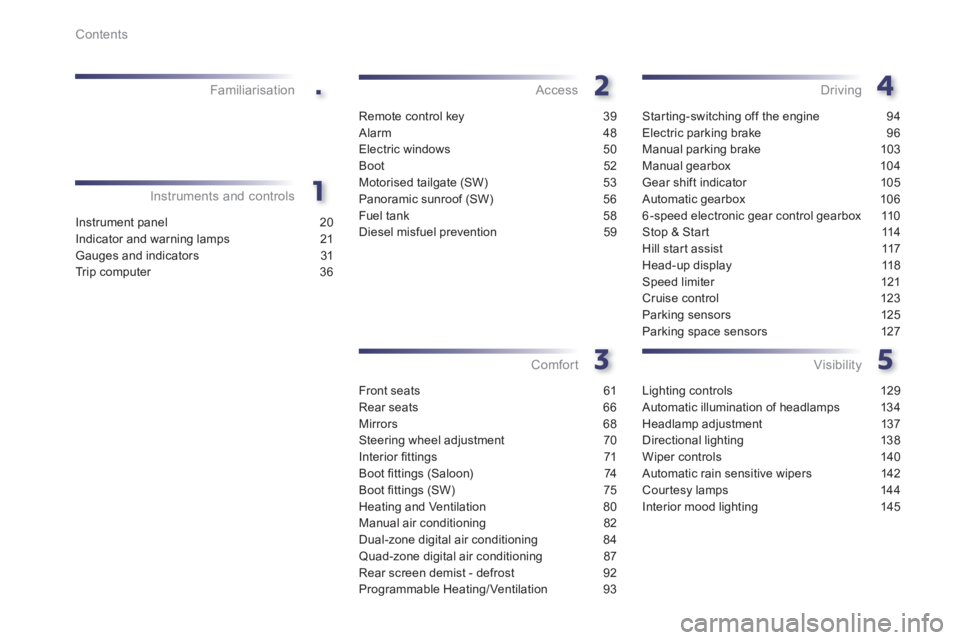
.
Contents
Instrument panel 20
Indicator and warning lamps 21
Gauges and indicators 31
Tr i p c o m p u t e r 3 6
Instruments and controlsFamiliarisation
Remote control key 39
Alarm 48
Electric windows 50
Boot 52
Motorised tailgate (SW) 53
Panoramic sunroof (SW) 56
Fuel tank 58
Diesel misfuel prevention 59
Access
Front seats 61
Rear seats 66
Mirrors 68
Steering wheel adjustment 70
Interior fi ttings 71
Boot fi ttings (Saloon) 74
Boot fi ttings (SW) 75
Heating and Ventilation 80
Manual air conditioning 82
Dual-zone digital air conditioning 84
Quad-zone digital air conditioning 87
Rear screen demist - defrost 92
Programmable Heating/ Ventilation 93
Comfort
Star ting-switching off the engine 94
Electric parking brake 96
Manual parking brake 103
Manual gearbox 104
Gear shift indicator 105
Automatic gearbox 106
6 -speed electronic gear control gearbox 110
Stop & Start 114
Hill start assist 117
Head-up display 118
Speed limiter 121
Cruise control 123
Parking sensors 125
Parking space sensors 127
Driving
Lighting controls 129
Automatic illumination of headlamps 134
Headlamp adjustment 137
Directional lighting 138
Wiper controls 140
Automatic rain sensitive wipers 142
Cour tesy lamps 144
Interior mood lighting 145
Visibility
Page 5 of 340
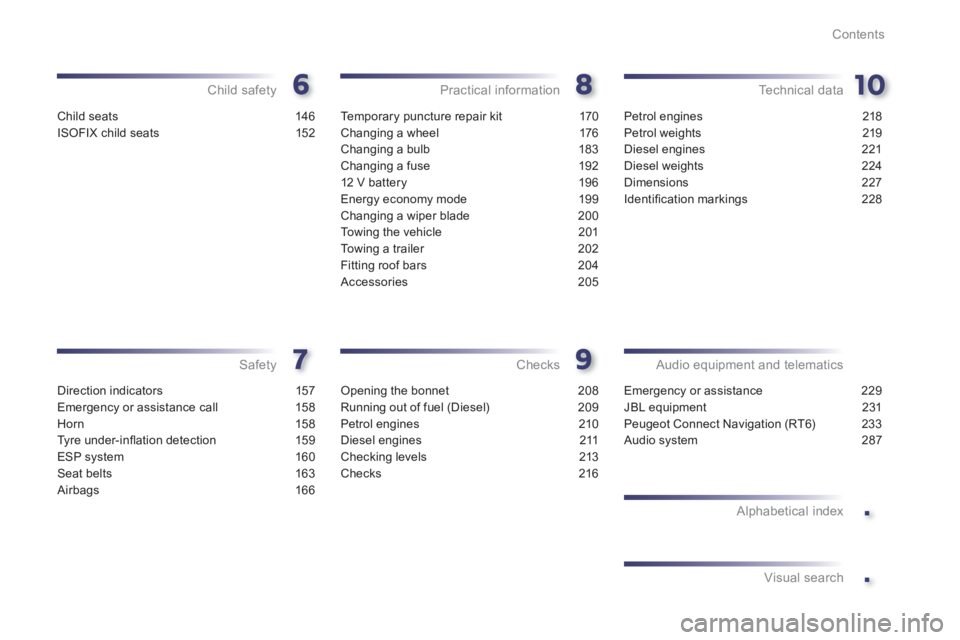
.
.
Contents
Child seats 146
ISOFIX child seats 152
Child safety
Direction indicators 157
Emergency or assistance call 158
Horn 158
Ty r e u n d e r- i nfl ation detection 159
ESP system 160
Seat belts 163
Airbags 166
Safety
Temporary puncture repair kit 170
Changing a wheel 176
Changing a bulb 183
Changing a fuse 192
12 V battery 196
Energy economy mode 199
Changing a wiper blade 200
Towing the vehicle 201
Towing a trailer 202
Fitting roof bars 204
Accessories 205
Practical information
Opening the bonnet 208
Running out of fuel (Diesel) 209
Petrol engines 210
Diesel engines 211
Checking levels 213
Checks 216
Checks
Petrol engines 218
Petrol weights 219
Diesel engines 221
Diesel weights 224
Dimensions 227
Identifi cation markings 228
Technical data
Emergency or assistance 229
JBL equipment 231
Peugeot Connect Navigation (RT6) 233
Audio system 287
Audio equipment and telematics
Alphabetical index
Visual search
Page 12 of 340
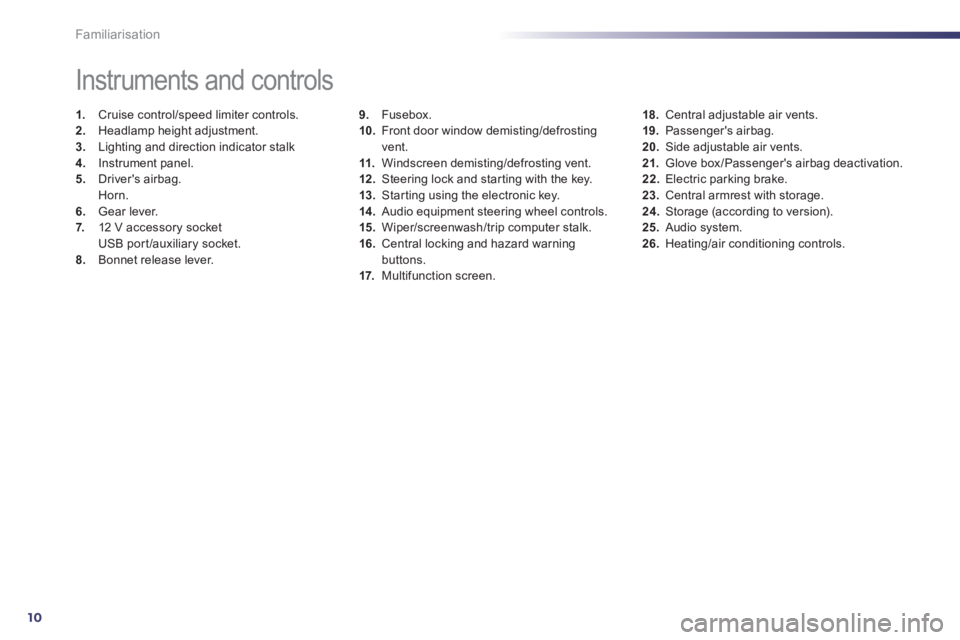
10
Familiarisation
9.
Fusebox.
10.
Front door window demisting/defrosting
vent.
11.
Windscreen demisting/defrosting vent.
12 .
Steering lock and star ting with the key.
13.
Star ting using the electronic key.
14 .
Audio equipment steering wheel controls.
15.
Wiper/screenwash/trip computer stalk.
16.
Central locking and hazard warning
buttons.
17.
Multifunction screen.
Instruments and controls
1.
Cruise control/speed limiter controls.
2.
Headlamp height adjustment.
3.
Lighting and direction indicator stalk
4.
Instrument panel.
5.
Driver's airbag.
Horn.
6.
Gear lever.
7.
12 V accessory socket
USB port /auxiliary socket.
8.
Bonnet release lever.
18.
Central adjustable air vents.
19.
Passenger's airbag.
20.
Side adjustable air vents.
21.
Glove box /Passenger's airbag deactivation.
22.
Electric parking brake.
23.
Central armrest with storage.
24.
Storage (according to version).
25.
Audio system.
26.
Heating/air conditioning controls.
Page 14 of 340
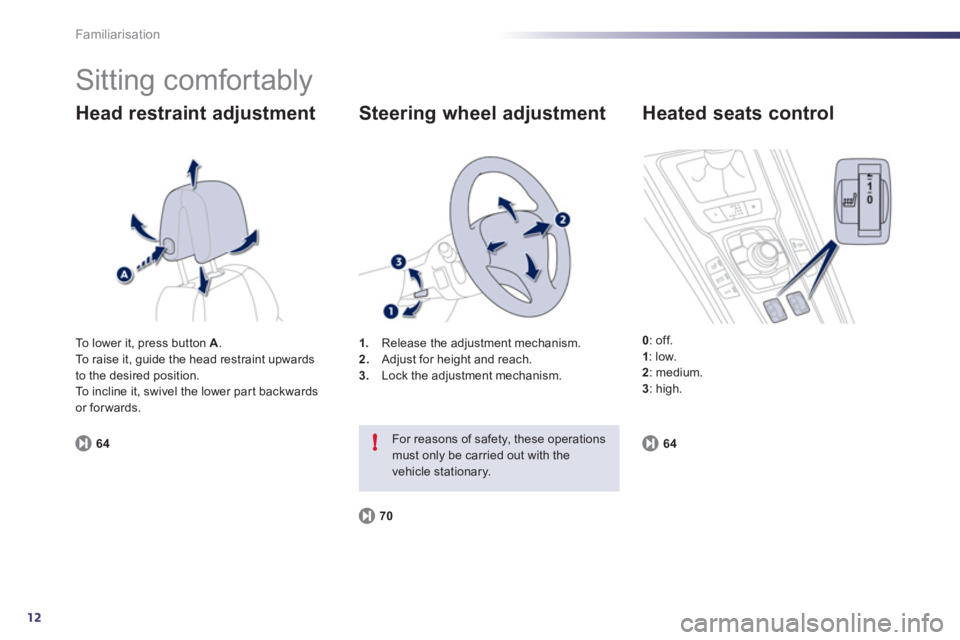
12
!
Familiarisation
Sitting comfortably
Head restraint adjustment
64
1.
Release the adjustment mechanism.
2.
Adjust for height and reach.
3.
Lock the adjustment mechanism.
Steering wheel adjustment
70
For reasons of safety, these operations
must only be carried out with the
vehicle stationary.
Heated seats control
0
: off.
1
: low.
2
: medium.
3
: high. To lower it, press button A
.
To raise it, guide the head restraint upwards
to the desired position.
To incline it, swivel the lower part backwards
or for wards.
64
Page 23 of 340
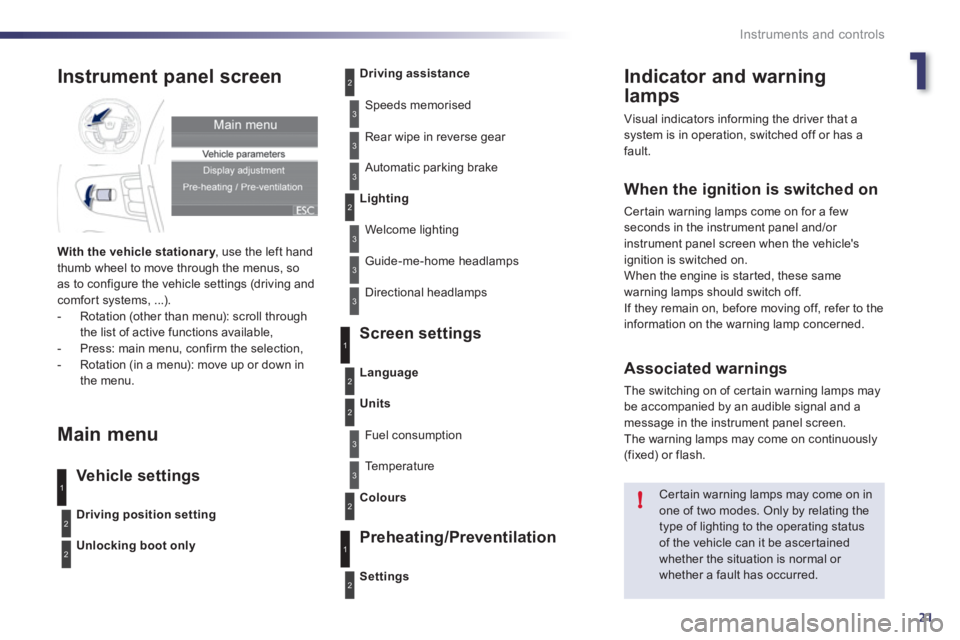
1
21
!
Instruments and controls
Indicator and warning
lamps
Visual indicators informing the driver that a
system is in operation, switched off or has a
fault.
When the ignition is switched on
Cer tain warning lamps come on for a few
seconds in the instrument panel and/or
instrument panel screen when the vehicle's
ignition is switched on.
When the engine is started, these same
warning lamps should switch off.
If they remain on, before moving off, refer to the
information on the warning lamp concerned.
Associated warnings
The switching on of cer tain warning lamps may
be accompanied by an audible signal and a
message in the instrument panel screen.
The warning lamps may come on continuously
(fixed) or flash.
Cer tain warning lamps may come on in
one of two modes. Only by relating the
type of lighting to the operating status
of the vehicle can it be ascer tained
whether the situation is normal or
whether a fault has occurred.
1
2
2
2
3
3
3
2
3
3
Instrument panel screen
With the vehicle stationar y
, use the left hand
thumb wheel to move through the menus, so
as to configure the vehicle settings (driving and
comfort systems, ...).
- Rotation (other than menu): scroll through
the list of active functions available,
- Press: main menu, confirm the selection,
- Rotation (in a menu): move up or down in
the menu.
Main menu
Vehicle settings
Screen settings
Preheating/Preventilation
Driving position setting
Unlocking boot only
Driving assistance
Speeds memorised
Rear wipe in reverse gear
Automatic parking brake
Lighting
Welcome lighting
Guide-me-home headlamps
Directional headlamps
Settings
Language
Units
Fuel consumption
Te m p e r a t u r e
Colours
3
1
2
2
3
2
3
1
2
Page 28 of 340
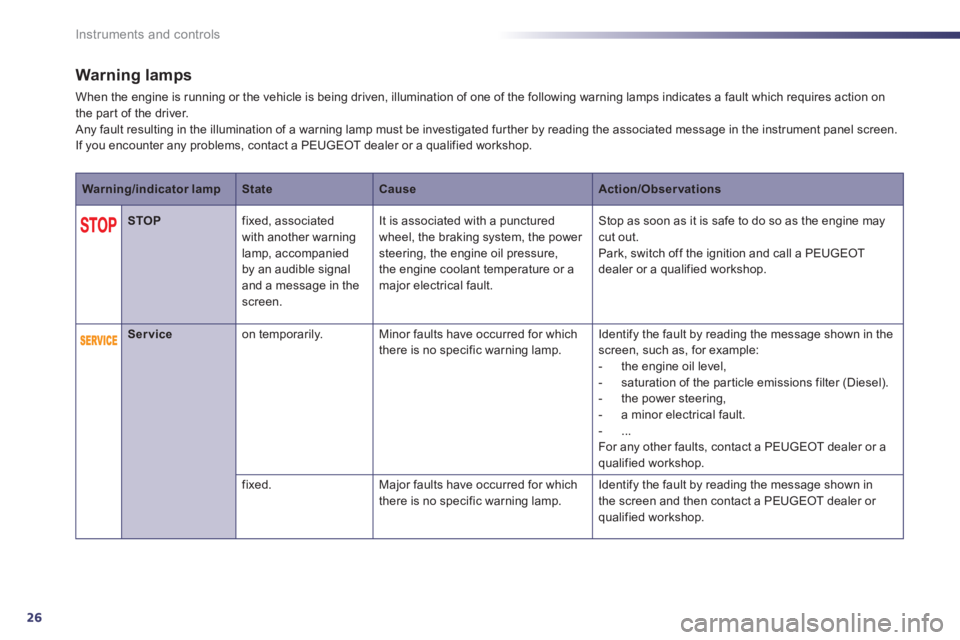
26
Instruments and controls
Warning lamps
When the engine is running or the vehicle is being driven, illumination of one of the following warning lamps indicates a fault which requires action on
the par t of the driver.
Any fault resulting in the illumination of a warning lamp must be investigated fur ther by reading the associated message in the instrument panel screen.
If you encounter any problems, contact a PEUGEOT dealer or a qualified workshop.
Warning/indicator lamp
State
Cause
Action/Observations
STOP
fixed, associated
with another warning
lamp, accompanied
by an audible signal
and a message in the
screen. It is associated with a punctured
wheel, the braking system, the power
steering, the engine oil pressure,
the engine coolant temperature or a
major electrical fault. Stop as soon as it is safe to do so as the engine may
cut out.
Park, switch off the ignition and call a PEUGEOT
dealer or a qualified workshop.
Service
on temporarily. Minor faults have occurred for which
there is no specific warning lamp. Identify the fault by reading the message shown in the
screen, such as, for example:
- the engine oil level,
- saturation of the par ticle emissions filter (Diesel).
- the power steering,
- a minor electrical fault.
- ...
For any other faults, contact a PEUGEOT dealer or a
qualified workshop.
fixed. Major faults have occurred for which
there is no specific warning lamp. Identify the fault by reading the message shown in
the screen and then contact a PEUGEOT dealer or
qualified workshop.
Page 39 of 340
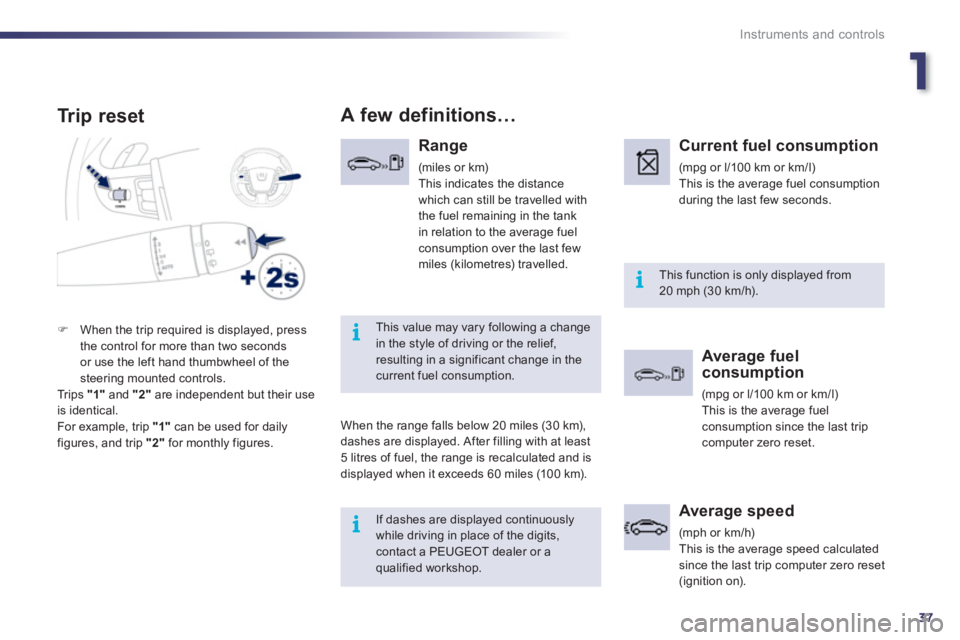
1
37
i
i
i
Instruments and controls
Tr i p r e s e t
If dashes are displayed continuously
while driving in place of the digits,
contact a PEUGEOT dealer or a
qualified workshop. This function is only displayed from
20 mph (30 km/h).
This value may vary following a change
in the style of driving or the relief,
resulting in a significant change in the
current fuel consumption.
A few definitions…
Range
(miles or km)
This indicates the distance
which can still be travelled with
the fuel remaining in the tank
in relation to the average fuel
consumption over the last few
miles (kilometres) travelled.
When the range falls below 20 miles (30 km),
dashes are displayed. After filling with at least
5 litres of fuel, the range is recalculated and is
displayed when it exceeds 60 miles (100 km).
Current fuel consumption
(mpg or l/100 km or km/l)
This is the average fuel consumption
during the last few seconds.
Average fuel
consumption
(mpg or l/100 km or km/l)
This is the average fuel
consumption since the last trip
computer zero reset.
Average speed
(mph or km/h)
This is the average speed calculated
since the last trip computer zero reset
(ignition on).
�)
When the trip required is displayed, press
the control for more than two seconds
or use the left hand thumbwheel of the
steering mounted controls.
Trips "1"
and "2"
are independent but their use
is identical.
For example, trip "1"
can be used for daily
figures, and trip "2"
for monthly figures.
Page 51 of 340
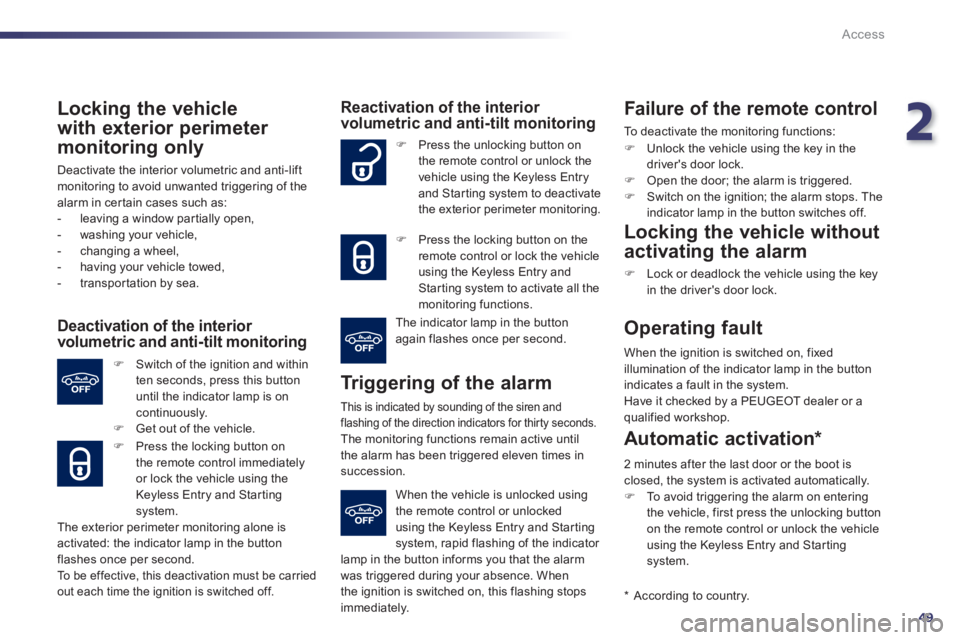
2
49
Access
Locking the vehicle
with exterior perimeter
monitoring only
Deactivate the interior volumetric and anti-lift
monitoring to avoid unwanted triggering of the
alarm in cer tain cases such as:
- leaving a window par tially open,
- washing your vehicle,
- changing a wheel,
- having your vehicle towed,
- transpor tation by sea.
Deactivation of the interior
volumetric and anti-tilt monitoring
�)
Switch of the ignition and within
ten seconds, press this button
until the indicator lamp is on
continuously.
�)
Get out of the vehicle.
�)
Press the locking button on
the remote control immediately
or lock the vehicle using the
Keyless Entry and Star ting
system.
The exterior perimeter monitoring alone is
activated: the indicator lamp in the button
flashes once per second.
To be effective, this deactivation must be carried
out each time the ignition is switched off.
Reactivation of the interior
volumetric and anti-tilt monitoring
Tr i g g e r i n g o f t h e a l a r m
This is indicated by sounding of the siren and
flashing of the direction indicators for thirty seconds.
The monitoring functions remain active until
the alarm has been triggered eleven times in
succession.
�)
Press the unlocking button on
the remote control or unlock the
vehicle using the Keyless Entry
and Starting system to deactivate
the exterior perimeter monitoring.
�)
Press the locking button on the
remote control or lock the vehicle
using the Keyless Entry and
Starting system to activate all the
monitoring functions.
The indicator lamp in the button
again flashes once per second.
When the vehicle is unlocked using
the remote control or unlocked
using the Keyless Entry and Star ting
system, rapid flashing of the indicator
lamp in the button informs you that the alarm
was triggered during your absence. When
the ignition is switched on, this flashing stops
immediately.
Failure of the remote control
To deactivate the monitoring functions:
�)
Unlock the vehicle using the key in the
driver's door lock.
�)
Open the door; the alarm is triggered.
�)
Switch on the ignition; the alarm stops. The
indicator lamp in the button switches off.
Locking the vehicle without
activating the alarm
�)
Lock or deadlock the vehicle using the key
in the driver's door lock.
Operating fault
When the ignition is switched on, fixed
illumination of the indicator lamp in the button
indicates a fault in the system.
Have it checked by a PEUGEOT dealer or a
qualified workshop.
*
According to country.
Automatic activation *
2 minutes after the last door or the boot is
closed, the system is activated automatically.
�)
To avoid triggering the alarm on entering
the vehicle, first press the unlocking button
on the remote control or unlock the vehicle
using the Keyless Entry and Star ting
system.